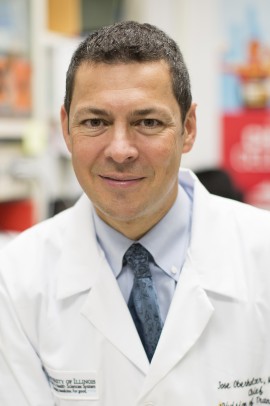Encapsulated human islet cells can normalize blood sugar levels in mice
For the first time ever, scientists studying a mouse model of diabetes have implanted encapsulated insulin-producing cells derived from human stem cells and maintained long-term control of blood sugar — without administering immunosuppressant drugs.
The results of the multi-institutional effort are published in Nature Medicine.

Dr. Jose Oberholzer, chief of transplantation surgery and director of cell and pancreas transplantation at the University of Illinois Hospital & Health Sciences System.
People with type 1 diabetes have an overactive immune system that destroys the insulin-producing islet cells in the pancreas. Lacking that hormone, the body fails to convert sugars to usable energy, and glucose rises to harmful levels in the blood without daily insulin injections. Islet cells have been successfully transplanted to treat type 1 diabetes, but those patients must take immunosuppressant drugs to keep their immune system from destroying the transplanted cells.
Previous research had shown that rodent islet cells could normalize blood sugar levels in animal models without immunosuppression if the cells were encased in hydrogel capsules. The semi-porous capsules allow insulin to escape into the blood, while preventing the host’s immune system from attacking the foreign cells. Larger capsules, about 1.5 millimeters across, even seemed able to avoid the buildup of scar tissue, which can choke off the cells’ supply of oxygen and nutrients.
The new study, a collaboration led by scientists at the Massachusetts Institute of Technology and Boston Children’s Hospital, used islet cells derived from human stem cells and capsules made of chemically-tweaked gel that are even more resistant to the build-up of scar tissue.
Dr. Jose Oberholzer, chief of transplantation surgery and director of cell and pancreas transplantation at the University of Illinois Hospital & Health Sciences System, professor of bioengineering at the University of Illinois at Chicago, and an author on the paper, tested several varieties of chemically-modified alginate hydrogel spheres — in various sizes — to see if any excelled at resisting scar-tissue formation.
Oberholzer and his coworkers at the University of Illinois at Chicago first tested the spheres to ensure they would allow the islet cells to function inside a host. Using a special microfluidic device developed at UIC under a grant from the National Institute of Diabetes and Digestive and Kidney Diseases, they delivered minute amounts of glucose into tiny wells containing encapsulated islet cells and measured the amount of insulin that seeped out. They implanted spheres that showed promise into rodents and non-human primates to look for the development of scar tissue.
They found (and reported in the journal Nature Biotechnology) that 1.5-millimeter spheres of triazole-thiomorphine dioxide (TMTD) alginate were best at allowing insulin to escape while resisting immune response and the buildup of scar tissue.
When implanted into a mouse model of diabetes, TMTD-alginate spheres containing human islet cells were able to maintain proper blood glucose control for 174 days — decades, in terms relative to the human lifespan.
“When we stopped the experiment and took the spheres out, they were virtually free of scar tissue,” Oberholzer said.
“While this is a very promising step towards an eventual cure for diabetes, a lot more testing is needed to ensure that the islet cells don’t de-differentiate back toward their stem-cell states or become cancerous,” said Oberholzer. If the cells did become cancerous, he said, they could easily break through the spheres.
Oberholzer also cautioned that a cure for human diabetes would require scientists to develop techniques to grow large numbers of human islet cells from stem cells — a worthy goal.
“In the United States, there are 30 million cases of type 2 diabetes and about 2 million patients with type 1 diabetes who could potentially benefit from such a procedure,” he said. “But we need to grow billions of islet cells.”
Co-authors on the papers are James McGarrigle, Meirigeng Qi and Matthew Bochenek of UIC; Daniel Anderson, Arturo Vegas, Omid Veiseh, Andrew Bader, Joshua Doloff, Jie Li, Michael Chen, Karsten Olejnik, Hok Hei-Tam, Siddharth Jhunjhunwala, Erin Langan, Stephanie Aresta-Dasilva, Srujan Grandham, Minglin Ma, Kaitlin Bratlie, Patrick Fenton, Alan Chiu, Sean Siebert, Katherine Tang, Nimit Dholakia, Raj Thakrar, Thema Vietti, Michael Chen, Jeon Woong Kang and Robert Langer of MIT and Boston Children’s Hospital; Douglas Melton, Mads Gurtler, Jeffrey Millman and Felicia Pagliuca of Harvard University; Jennifer Hollister-Lock, Josh Cohen, Karolina Siniakowicz and Gordon Weir of the Joslin Diabetes Center; and Dale Greiner, Stephen Lyle and David Harlan of the University of Massachusetts Medical School.
This work was supported in part by the JDRF and Leona M. and the Harry B. Helmsley Charitable Trust (Grant 3-SRA-2014-285-M-R), National Institutes of Health grants EB000244, EB000351, DE013023 CA151884, UC4DK104218, P41EB015871-27, R01DK091526, the MIT SkolTech initiative, the Tayebati Family Foundation, the Chicago Diabetes Project, and Koch Institute support grant P30-CA14051 from the National Cancer Institute.
